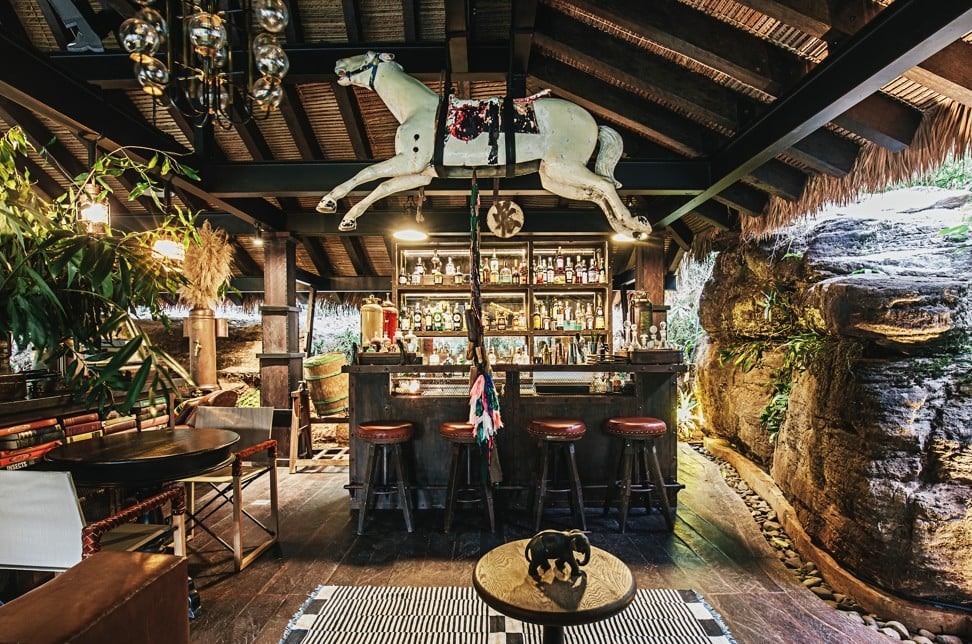
Shinta Mani Wild: at the glamorous rainforest retreat, guests patrol the forest after arriving by zip line
- Accompanying gun-toting anti-poaching patrols a highlight at this Bill Bensley-designed eco-lodge
- The architect bought the 350-hectare plot to offer an unrivalled guest experience while protecting the environment
Jungle resort, eh? Well, secondary jungle. The primary rainforest in this part of southern Cambodia’s Cardamom Mountains was logged out in the free-for-all of the 1990s and 2000s. Shinta Mani Wild lies within Kirirom National Park, on the eastern edge of Southern Cardamom National Park, designated in 2016 to conserve Southeast Asia’s largest unfragmented rainforest. This biodiversity gem contains more than 2,000 species of plants and at least 50 globally threatened species of vertebrates, including elephants, clouded leopards and black bears.
How is that achieved? With the help of a naturalist and a ranger station. Munny Van keeps watch on the wildlife and poachers with the help of cameras throughout the property. He also gives guests tours of his trails, identifying droppings and pointing out claw marks on tree trunks. Shinta Mani funds a Wildlife Alliance station and its rangers patrol daily, accompanied by armed police. They remove snares, report logging, confiscate chainsaws, stop people taking land for themselves and check the wildlife-tracking cameras.
What if they come across miscreants? If possible, the police will make an arrest. Guests can see the rangers in action by joining a patrol through the forest, up hill and down dale, for a half or full day. A tall ranger led my patrol, supported by two Kalashnikov-wielding military policemen, from the post at the entrance to the property. Cautiously treading muddy paths overhung with foliage, the ranger cast a gimlet eye to left and right. The only evidence of a misdemeanour we found, though, was a fruit tree toppled by an elephant, which had already fled the scene. No arrest was made.

Zip-a-dee-doo-dah – is this the place with the amazing arrival arrangements? Yes – you get a literal overview of the place on your way in, strapped onto a zip line and whizzing 380 metres over the trees to the Landing Zone bar, in the heart of the resort. The faint-hearted can continue by SUV to the Headquarters, as the resort’s hub is known. Besides the open-sided bar with deep leather armchairs and lavish coffee-table books, there’s an open-sided restaurant on two levels, with views towards a sadly denuded mountainside and – just below – a waterfall that roars in the rainy season.
What’s there to eat? There are daily specials at breakfast, lunch and dinner, or the chef will knock up whatever you request, if he’s got the ingredients, some of which he forages from the forest. He will gladly take you along on one of his forays into the foliage. The bar is splendidly stocked – order whatever concoction you like without a care about bills, a barfly’s dream. Your own butler will deliver meals to your tent, if you like, setting the table for you; he is on 24-hour call for anything, in fact.
Tents, you say? Well, that’s a fudge. They are actually solidly built chalets, with huge picture windows made of plastic, which can be unzipped and rolled up, giving all-round open-air views. For fresh air at night, leave them that way, but lower the mosquito screens. In designing the 15 “tents”, Bensley imagined what the accommodation might have been like had former United States first lady Jackie Kennedy taken a jungle safari when she visited King Norodom Sihanouk in Cambodia, in 1967.

The First Lady Jackie Kennedy’s Tent is full of ephemera documenting her visit, while decor elsewhere includes steamer trunks, valve radios and old hard-bound books. But no televisions. Each 50-square-metre tenthas varnished floors and surfaces, and a gigantic bed that’s so highyou’ll need a chair to get in. Why? “That’s Bill Bensley,” says general manager Sangjay Choegyal. Has anyone fallen out? “Not yet,” he says, smiling.
Any balcony? Oh yes. And on the large deck you can lounge on a wildlife-print sofa or soak in a glorious bathtub. Screened by the forest from other chalets, you are free to be a naturist on your own patch. Imbibe at the maxibar on wines, Taittinger champagne and cut-glass decanters of mysterious dark rum, whisky and gin.
What’s the bottom line? Three-night stays are the minimum and start at US$2,345 a night, which covers everything, including spa treatments. On arrival at the airport, resort staff will whisk you through immigration to an SUV for the drive to the property (three hours from Phnom Penh; two hours from Sihanoukville).

